Quick, agile CX-3 swaps room for 38+ mpg
Filed under: Weekly test drives, Autos
By John Gilbert
Our younger son, Jeff, sent us a carefully selected gift combining a birthday (that would be my wife, Joan) and father’s day (that’d be me). It was a pair of well-positioned seats for the Bruce Hornsby concert at Big Top Chautauqua in mid-July.
Located just a few miles south of Bayfield, Wis., we’ve always enjoyed spending a summer evening at a Big Top concert after an afternoon strolling around the shops and waterfront of Bayfield.
It would be more memorable this time, because we’d never seen Bruce Hornsby. Jeff insisted he has rounded up a high-skilled backup band and he knew we had never seen them, plus he knew we’d enjoy the show. On top of that, it was the perfect opportunity to test my long-standing theory about how small SUVs can often outdo larger vehicles, because my test-vehicle of the week was a glistening metallic-white Mazda CX-3.
With Mazda selling a large CX-9 for those who need to carry three rows-worth of seats-full, and a slick CX-5 for those compact crossover types who are shopping Honda CR-V, Toyota RAV4, Nissan Rogue, and Hyundai Tucson SUVs, the CX-3 is aimed at the new, still more compact, crossovers.
With technology at the forefront of the newest vehicles, Mazda has that covered. Mazda builds a potent 2.5-liter 4-cylinder that works well in the CX-9 with a turbocharger, or normally-aspirated in the CX-5 and large-sedan Mazda6. The same Skyactiv technology works even more impressively on the 2.0-liter 4-cylinder — which has become my favorite Mazda engine in either the Mazda3 or the CX-3.
It revs quickly, packs a punch beyond what its 146-horsepower/146-foot-pounds of torque might imply, and gets fantastic fuel economy. I was alerted that the newest CX-5 with G-Vectoring and the larger engine, would be a better choice because it is only 1 mpg off the 2.0. The EPA estimates may not be duplicated in real-world tests, however, a fact I realized after the 2.0 showed more like 10-12 mpg better than the 2.5. Maybe it helps to stay off long-haul, high-speed freeways.
We had earlier taken a drive up the North Shore of Lake Superior to Grand Marais, the little artsy Minnesota town that just won the award as the best small town in the U.S. The CX-3 handled that daytrip with ease, and it was more of the same heading for Bayfield.
Big Top Chautauqua is always a nice trip from Duluth, Mn., being just under 100 miles, at an estimated time of just under 2 hours. You travel through lightly populated areas on good highways whether you take Wisconsin 13 close to the South Shore of Lake Superior or the more mainline Hwy. 2 to Washburn and then drive North on 13. The huge blue and white tent at Big Top Chautauqua sits at the bottom of a ski hill and houses amazing acoustics and a schedule filled with impressive performers. We usually take Hwy. 2, but this time we took Hwy. 13 and came into Bayfield from the North.
With a full tank of gasoline, and some snackable mixed nuts and cans of Perrier, our Mazda Touring CX-3 was ready to renew my personal philosophy: Anything bigger than big enough is too big. Aside from being cumbersome to maneuver and no fun to drive, large SUVs are just waiting for fuel prices to climb.
Mazdas, meanwhile are always fun to drive, whether sports car, small sedan, large sedan, or SUV. The CX5 handles like a sports sedan and has the added power of the 2.5, but I can’t imagine anyone accusing the CX3 of being anything but peppy. Unless it is to compliment it on being an incredible over-achiever when it comes to fuel economy.
I’ve often found that the numbers don’t matter to validate Mazda vehicles, and they often don’t add up in assessing its engines. We were not flying at 75 or 80, but stayed comfortably within the 60 or 65 mph speed limit all the way down and back. We clicked the house-built 6-speed automatic into “normal” setting or “sport” mode, which stiffens the suspension, firms up the steering, holds the revs higher in each gear, and blocks out the overdrive and super-overdrive fifth and sixth gears.
As we drove, I watched the computerized fuel device climb, up to 30 miles per gallon, and then higher, and higher. When we pulled into the trendy little town of Bayfield, that gauge said 38.4 miles per gallon! Thirty-eight point four? Compact or not, this is an all-wheel-drive SUV that could turn hillside climbs up snowy and icy hills a simple and even joyful procedure. And it delivered 38.4. Read more
QX30 and Q60 both spell winners
Filed under: Weekly test drives, Autos
By John Gilbert
Sometimes it gets annoying when you sit down to read your favorite monthly auto magazine, and find out that for the umpteenth consecutive issue, they’ve lumped six vehicles together for what seems like a quite convoluted and possibly biased comparison.
Here at New Car Picks, we don’t sink to such a trick…Except sometimes. This week, I would really rather devote a full column to the Infiniti QX30 Premium crossover SUV, and another full column to the Infiniti Q60, a super-sleek luxury sports coupe.
Separately, they are two of my favorite cars on the planet. But together, they could satisfy any family’s demands for having a sporty coupe and an SUV. And two versions of those gems arrived for me to drive for a week’s test drive in fairly close-order. Separating the two into separate road-tests is still my preference, but their close proximity in coming to me made it a natural to combine them into one elongated road test.
The two are joined at the hip — or maybe the transaxle — by sharing the extremely impressive 2.0-liter turbocharged 4-cylinder engine that has excellent power and even more impressive fuel economy. That 2.0 direct-injected 4 began life as a joint venture with Mercedes, which needed someone to produce just such a 4-cylinder for use in the C-Class sedans, and the smallest Mercedes SUVs, the GLA. Contracting with Nissan made a joint venture that gives a version of that engine to both companies. Read more
New elongated Tiguan springs from VW for 2018
Filed under: Equinox, Autos
DENVER, Colorado
Just west of Denver, the Rocky Mountains rise from the Mile High City’s 5,280 feet to peaks jutting more than 10,000 feet into the sky. They can be traversed by twisting roads up to and along the Continental Divide, but you do it with care, and you’d best have a vehicle that handles with great precision.
What better place for Volkswagen to introduce its new 2018 Tiguan? After all, a Tiger, or an Iguana, could make that climb with ease, and legend has it that back in the days when VW assigned real-world elements to its vehicles — Golf for gulf wind, Jetta for jetstream, Scirocco for desert wind, etc. — somebody decided that the first stubby and squarish sport-utility vehicle might best be named by combining the stealth of the tiger and the lizard-like maneuverability of the iguana.
Far as we could tell, there were no tigers, nor iguanas, out cavorting in the 98-degree heat during our wave of the global launch of the all-new Tiguan. But that’s OK; the new Tiguan handled every road-challenging turn and switchback with great poise and delivered impressive power and fuel economy both on the way up and coming back down to our base at the Halcyon Hotel in suburban Cherry Creek.
My driving partner was a fellow we’ll call Wayne, an incurable devotee to fuel efficiency. He slows down a block away when he sees a street light turn red ahead, so that he can avoid gas-robbing stop-and-goes, where moderate speed can allow him to continue forward. He also doesn’t exceed the speed limits on suburban steets, causing others in our group to line up behind us in frustration.
But when we partner, I find myself driving more rationally, and trying to also maximize fuel efficiency even while using more burst of power to exercise a vehicle’s handling capabilities. We both like to stop and shoot photos at scenic spots. So this was a good match.
The night before our drive, we gathered at the hotel’s penthouse suite for a buffet dinner that was outstanding. It was there we heard some other journalists who had just finished the previous wave grumbling about the Tiguan’s lack of power and boring ride characteristics. We were not anticipating anything outstanding, but the Tiguan delivered exactly that in surprising quantities.
I never disliked the original Tiguan, stubby and square though it is, it just seemed to lack the style brought about by the new explosion of compact crossover SUVs.
After all these years, this will be the first renovation of the Tiguan, and the old Tiguan will continue to be built for the near future as the Tiguan Limited. Every company making SUVs are now caught up in the craze to make smaller and more compact models, and here is Volkswagen, already with a reasonable compact, choosing to build a larger one.
The new one is 10.7 inches longer and it fits on VW’s excellent new MQB platform, a modular chassis that can house every car and SUV with a transverse engine design. The side-mounted engine at the front of the new Tiguan is the familiar 2.0-liter turbocharged 4-cylinder, except it is entirely new. VW’s engineers are always creating new concepts in engine building. They have made a 2.0 for decades and it has served the company well in all manner from efficient to the screaming powerplant of the GTI. More recently, VW added a 1.8-liter engine that was a downsized derivative of the 2.0.
And one year ago, VW came out with a superb new 1.4-liter turbo that is the first of an entirely new high-tech family of engines. So when I learned the Tiguan would have a 2.0, I had to ask Mark Gillies if this one was an enlarged version of the 1.4 or a redone version of the old 2.0.
“It actually is a revised version of the EA 888 — the old 2.0,” said Gilles, senior manager of production and technology for Volkswagen of America. “It is called the ‘Butack’ engine, named after the engineer who designed it with a revised Miller-cycle system that closes the intake valves early, increasing combustion time, and allos the variable cams to open longer and wider when you need more power.”
There is another example of VW engineering genius. With new engines seeming to aim at replacing old ones, VW keeps the old ones around back in the laboratory where an engineer named Butack might find the time to extract a whole new future for it. Read more
Versatile Elantras even challenge Sonata
Filed under: Equinox, Autos
By John Gilbert
LA JOLLA, CALIF.
Hyundai has never gotten the acclaim it deserves for shattering convention in the placid realm of midsize autos, forcing all competitors to revise their concepts as well as their cars and powertrains. It was in 2010 that Hyundai brought out the 2011 Sonata, as its conveyance to elite status in the auto world
It had dramatic new styling, with contours covering both sides and a sleek shape overall; a new 2.4-liter engine with an expensive and efficient direct-injection system that could attain 40 miles per gallon at freeway speeds; a body that, while shapely, was amazingly strong because of the predominance of high-strength steel; new house-built 6-speed stick and automatic transmissions; and all in a less-expensive package than more dominant midsize Accord, Camry, Mazda6, Altima, Malibu and Fusion.
That car thrust Hyundai into a previously unattained status in the car business, and forced competitors to shake out of their complacent lethargy and realize there were better ways to build cars and engines. Several updates and revisions have followed, raising the segment dwellers substantially for their 2017 models, with more to come in 2018.
While all of the midsize competitors have improved greatly in recent years, the smaller compact cars also have grown up and now boast remarkable improvements
At Hyundai, that means the last compact Elantra that came out, in 2015, has moved up in station to challenge the larger midsize stalwarts.
With that, we drop in out of the friendly skies to visit Torrey Pines Resort in La Jolla, California, .a suburb of San Diego that also includes a world-class golf course, along the Pacific coastline. It is a wonderful resort, and it is not far down the Coast from Hyundai’s U.S. base offices. That made it convenient as the site for waves of automotive media to experience the first drives of both the 201 Sonata, and the 2018 Elantra Sport and GT.
Hyundai gave the Sonata the leadoff slot as the flagship of the company’s identity in the U.S. market, and we had to wait until the next day to examine and drive the Elantra Sport and GT. That was intriguing, because the Sonata, looking more luxurious than ever and with refined driving capabilities, is really a well-crafted mid-cycle update, with stylish new front and rear designs, while the Elantra Sport and GT are entirely new.
We can introduce both of them together, but add the caution that you may be lured into the Hyundai dealership by the roomy and stylish Sonata, but do not overlook the equally flashy and conveniently sized Elantra, Elantra Sport, and Elantra GT.
My preference always has favored midsize cars, but as midsize cars grow in size to now approach full-size vehicles in roominess and luxury, the compacts have slyly grown too, and now are pretty much the size you may prefer in your quest for a midsize car.
The Elantra came out early in this calendar year, and the Elantra Eco, with a new-generation 1.4-liter turbocharged engine, followed in April. The Elantra GT comes next, available about November, and it will be the prize of the litter for folks who appreciate sporty driving and vehicles that respond well to sporty input. At a base price of $21,650, the Elantra Sport is a strong value for bargain shoppers still craving some fun in their driving
Any question of the Elantra GT’s credentials are eliminated by realizing it began life as the i30 in Europe, a sporty hatchback that likes to take on the Golf GTI and the hottest Ford Focus ST — with a sizzling turbo 2.0 that produces either 247 or 271 horsepower, both with 260 foot-pounds of torque. The best way to get the Elantra GT is the GT Sport package, which takes a large step up from the everyday Elantra GT. The U.S. version of the Elantra GT has the 2.0 engine without the turbocharger and with 162 horsepower at 6,200 RPMs, and 150 foot-pounds of torque at 4,700. It comes with either a 6-speed stick or 6-speed automatic.
The GT Sport parlays the 1.6-liter turbo 4 — my favorite — with a standard 6-speed stick or a 7-speed dual-clutch transmission and paddles. That package has 201 horses at 6,000 revs, and 195 foot-pounds of torque from 1,500-4,500 RPMs. The GT Sport also has multilink rear suspension and 18-inch wheels, compared to the torsion beam rear suspension and 17s in the Elantra GT.
Strangely, there are some items available on the GT Sport that are unavailable on the Elantra GT, such as blind-spot detection with rear cross-traffic, lane change assist, lane keep assist, smart cruise control, automatic emergency braking with pedestrian detection, and high beam assistance. Both vehicles have stability control, traction control, hill-start assist brake assist and rearview camera.
More curiously, while the Sonata has discontinued the very impressive panoramic sunroof for 2018, but the Elantra GT and Sport will offer it. The Sport has more bolstered bucket seats up front. The cars are built using 53 percent high-strength steel, leading to an 18 percent increase in the GT’s torsional rigidity, and the GT Sport is 22 percent more rigid and 61 pounds lighter than the previous model, with under-car cladding to improve aerodynamics to a 0.30 cd.
Driving on a hot day in the California mountains, we appreciated finding ventilated front buckets with cool air coursing through the seats. And the Infinity audio system has seven speakers and a subwoofer with plenty of power.
Along with all the contemporary connectivity devices and outlets, the remote start can be programmed into your smartphone, which can also turn on your rear defroster on cold mornings. The smart cruise has full stop-start, and there’s a driver attention assist as well.
We drove pretty hard and appreciated the precise feedback and curve-tracking capability of the Elantra GT and Sport GT, which put its quick-revving 1.6 turbo to good use. Hyundai estimates its previous 40-percent stick shift sales might be reduced to 20-40 percent, but that’s still high these days. The company also projects 15 percent of Elantra buyers will take the turbo, leaving 85 percent the rest of the line.
Statistically, the Elantra GT and Sport will have to take on a crowded compact field. The Elantra GT’s 55.1 cubic feet of interior storage will handle that well, compared to the Civic’s 46.2, Chevrolet Cruze 47.2, Mazda3 47.1, Focus 43.9 and Golf 52.7. One other interesting stat: We drove hard over the mountain roads and registered a surprising 41 miles per gallon
The Elantra is competitive enough that it might also challenge the larger and more profitable Sonata in overall room, as well as handling and performance. The lighter Elantra is 170.9 inches long compared to the Sonata 191.1; Elantra wheelbase is 104.3 inches to 110.4; width 70.7 to 73.4; and height 57.7 to the Sonata’s 58.1. That sounds like a big difference, but the Elantra Sport front and rear headroom is close to Sonata’s: legroom is 3 inches less front and 0.8 inches less in the rear, while shoulder room is also close, 56.2 inches front and 55.4 rear to the Sonata’s 57.9 front and 56.5 rear. The overall interior space is 121.4 in the Elantra to 122.4 in the Sonata.
Comparing designs of the 2018 Sonata and Elantra Sport makes it evident that the Sonata is intending to move upscale, and at that, it has the style, technology and roomy comfort to carry it off. The Elantra Sport, meanwhile, becomes a viable choice for a few thousand less, almost the same roominess, and the adventuresome look of the hatchback.
The larger midsize cars seem the most squeezed by the current rush to SUVs. New models of Accord and Camry have tried to catch the superb Mazda6 and jacked up the segment, and now into the midst of it all comes the seventh-generation Sonata, as a 2018 model.
When the 2011 Sonata breakthrough hit, it was very popular but drew criticism from skeptics who thought the curvaceous bodywork would be too trendy and might look old before its time. That was an erroneous theory, because while Hyundai scrambled to go back to more conservative designs in every revision, and it now looks quite generic — next to the still-distinctive 2011 Sonatas, which stand out as exclusive and readily recognizable.
For the 2018 refreshing, Hyundai hired Edward Lee, a young designer who had been working at Lexus. He said his task was a mission statement, “to create an instant ‘Wow!‘ factor.” Lee added that, “We aimed for a striking design starting with the side, where the shape starts low, from the tension of the nose.
“The front and rear have a new, upright athletic appearance. My favorite views are the front corner, where the contour lines come across the hood and angle down to the outer edges of our cascade grille, and a high view of the rear corner, which is much cleaner and emphasizes the car’s width and have a fresh, modern look, in what might be called horizontal elements in vertical arrangement. I like the way the lines, which connect the headlights and sweep back, all meet at the taillights.”
Lee confided that he, too, liked the look of the 2011 Sonata, and while he stopped short of saying he was attempting to reverse the trend, he acknowledged his first assignment for Hyundai was to make the Sonata more exciting.
John Shon, the senior product planning manager, talked about the signature cascade grille, which consists of horizontal bars aligned just right to amplify the hexagonal grille opening. With the broad horizontal top edge, then a short upper side bar, tapering down along longer lower side moldings to the bottom bar, the cascade term refers to the way molten steel flows out and downward. That, too, has meaning, because Hyundai is the only auto-maker that owns its own steel plant, which is why its cars are loaded with the costliest — and safest — high-strength steel.
My partner and I drove a Sonata Limited with the 2.4-liter 4-cylinder, and it handled the terrain and the curves of the mountain roads just east of La Jolla very well. After lunch in the mountain-area town of Julian, we switched to the Sport, with the 2.0-liter turbocharged engine. And proved conclusively that the quicker-revving engine, wider wheels and Michelin tires made a big improvement in handling and performance.
The range of Sonatas consists of the base SE 2.4 ($22,050 base price); the Eco 1.6-turbo ($22,650); the SEL 2.4 ($23,700); the SEL Tech 2.4 ($24,700); the Sport 2.4 ($25,200); the Limited 2.4 ($27,400); the Limited Ultimate 2.4 ($30,300); the Sport 2.0t ($27,600); and the Limited Sport 2.0t ($32,450).
The 2.4 is naturally aspirated with direct injection — the engine that put Hyundai on the international map as the joint venture still used by Fiat-Chrysler and Mitsubishi — and delivers a solid 185 horsepower at 6,000 RPMs and 178 foot-pounds of torque at 4,000 RPMs. The 2.0-turbo has 245 horsepower at 6,000 RPMs, and 260 foot-pounds at a steady flow from 1,350 to 4,000 RPMs. And the 1.6-liter turbo has 178 horsepower at 5,500 RPMs, and 195 foot-pounds from 1,500-4,500 RPMs.
The 2.4 comes with a 6-speed automatic, built by Hyundai, and the 2.0 turbo comes with the company’s upgraded 8-speed automatic, and both have Shiftronic to allow manual overrides. The 1.6-turbo has a higher-tech 7-speed dual-clutch automatic in the Eco, which will be out later this year. Hybrid and plug-in hybrid models will come out next year.
I liked the Sonata 2.0-Sport because it had paddles on the 8-speed automatic, and coming down from the mountains the paddles allowed me to drop down to fifth, fourth, or even third, and negotiate switchbacks without excessive braking. There was some excessive braking at one point, when a line of about 20 cars was stopped for a lengthy delay because of a rockslide that had come down from the bluff to our left and covered the two-lane highway. We didn’t mind pausing to let them clear that mess.
The Sonatas are built mostly at Hyundai’s Montgomery, Ala., plant, and at first, we assumed that was the more newsworthy. But the smaller Elantra was bigger news one day later, and unless I miss my guess, it will captivate you the same way in the showroom.
Volvo’s new XC60 might prove less is more
Filed under: Equinox, Features, Autos
By John Gilbert
BARCELONA, SPAIN
Driving in Spain is a colorful adventure that I had experienced once before, so I felt somewhat familiar during the global auto media’s first opportunity to drive Volvo’s new XC60, the all-new midsize derivative of its superb XC90 SUV.
Volvo stressed the quick and agile handling of the smaller and lighter vehicle with the same powertrain as the larger XC90, which collaborated with Spain’s freeway exits to instantly become more concise than words could describe.
On the North American side of the Atlantic, our freeway exits are usually pretty straightforward — you see the exit and veer onto it, heading for another freeway. In Spain, the freeway system was added to centuries-old cities and rural regions, so it’s a little trickier. Often, you head onto an exit and find it immediately splits right and left. I learned this on my first driving trip to Spain, for the splendid S90 Volvo sedan.
On this trip, our total test drive route was programmed into the navigation setting of our T6 all-wheel drive XC60, so we were informed of upcoming moves by a “Nav Lady,” whom we shall refer to as a “Nav Seniorita” for the sake of geographic accuracy. I drove first, so my co-driver/passenger — a Californian who shall be called “Billy” — could check out the wonderful scenery along and just inland from the Mediterranean without worrying about directions.
Our next exit was to the right and our Nav Seniorita said: “Prepare to keep right and take the next exit, then immediately keep left.” As I pulled into the right lane, she said, “Take the next exit.” Smoothly and at about 80 kilometers per hour I eased off onto the exit. Then with what seemed like urgency the Nav Seniorita said: “Now keep left!”
You don’t want to miss an exit in the Land of Roundabouts, so I abruptly swerved back to the left of the exit barrier, and as the XC60 easily cleared the barrier, but Billy said, “No! Stay right!”
I swerved very abruptly back to the right, still missing the barrier with ease and getting back onto the exit, as the XC60 held its attitude with more poise than its driver, who might have been reflecting the adrenaline rush rising to max. I spotted the split immediately ahead and stayed left, making it smoothly.
I was impressed that I had reacted instantaneously twice, with two very abrupt left-right swerves at highway speed, and more impressed that the XC60 got it right-on, even while our Nav Seniorita was a bit premature with her counter-direction. The vehicle carried out my impulses without any squeals of complaint or any hint of body roll.
Inadvertent or not, it’s always nice to get a real-world example of a vehicle’s features rather than just to accepting marketing claims. We believed them when they talked about the lighter and smaller XC60 having better agility than the XC90, because in totally revising the XC60, Volvo took the XC90’s SPA — Scalable Product Architecture — shortened it, and installed the same high-tech powertrains from the XC90 with all-new suspension stuff. Read more


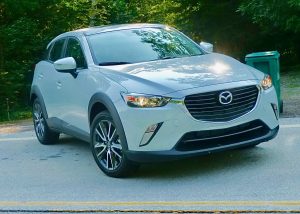
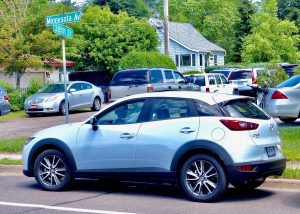
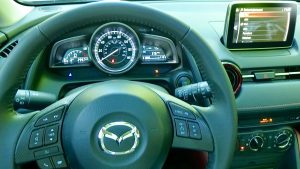
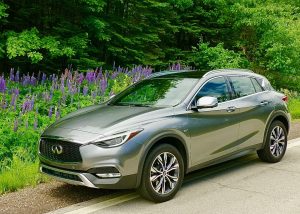
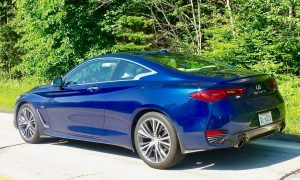
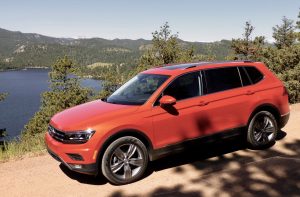
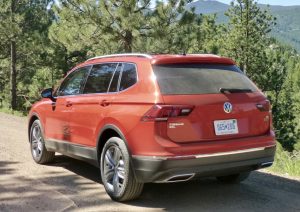
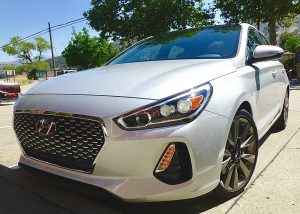
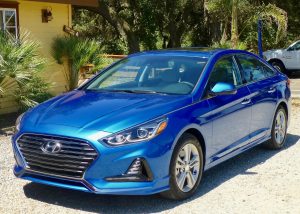
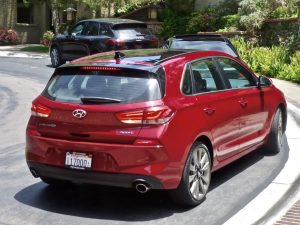
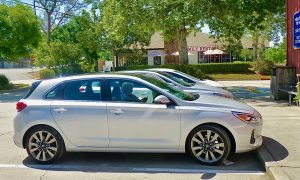

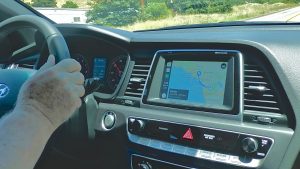
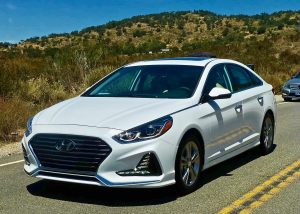
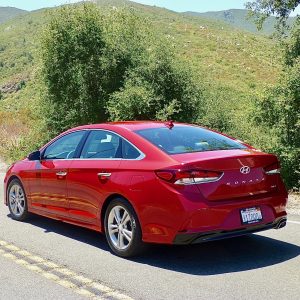
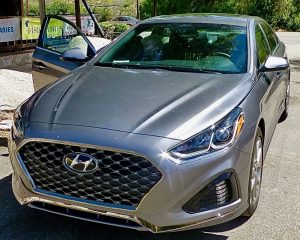
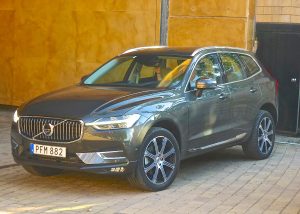
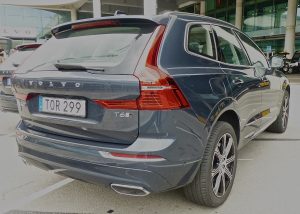
 John Gilbert is a lifetime Minnesotan and career journalist, specializing in cars and sports during and since spending 30 years at the Minneapolis Tribune, now the Star Tribune. More recently, he has continued translating the high-tech world of autos and sharing his passionate insights as a freelance writer/photographer/broadcaster. A member of the prestigious North American Car and Truck of the Year jury since 1993. John can be heard Monday-Friday from 9-11am on 610 KDAL(www.kdal610.com) on the "John Gilbert Show," and writes a column in the Duluth Reader.
John Gilbert is a lifetime Minnesotan and career journalist, specializing in cars and sports during and since spending 30 years at the Minneapolis Tribune, now the Star Tribune. More recently, he has continued translating the high-tech world of autos and sharing his passionate insights as a freelance writer/photographer/broadcaster. A member of the prestigious North American Car and Truck of the Year jury since 1993. John can be heard Monday-Friday from 9-11am on 610 KDAL(www.kdal610.com) on the "John Gilbert Show," and writes a column in the Duluth Reader.